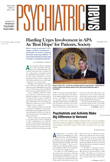Mental illness is now the leading cause of hospitalization among children and adolescents in Washington state, according to a recent study of admission figures by researchers at the University of Washington.
While overall hospitalization rates declined by 34 percent for children and teens in Washington in the 1990s, hospitalization rates for mental illness remained steady for adolescents and increased by 20 percent among children aged 5 to 14. During 1998-99, mental illness accounted for 12 percent of hospital admissions for children in that age group and 20 percent of the admissions for adolescents, according to Michelle Garrison, M.P.H., an epidemiologist at the University of Washington Child Health Institute.
An additional 3 percent of children aged 5 to 14 and 6 percent of adolescents hospitalized in 1998-99 had a secondary diagnosis of a psychiatric disorder, Garrison reported at the 2002 meeting of the Pediatric Academic Societies.
In an interview with Psychiatric News, Garrison said the causes of the surprise findings are not known and will be the subject of further investigation.
“There are several different possible explanations,” she said. “It could be that the prevalence of these disorders is increasing, or the severity is increasing. Or it could be that treatment patterns are changing. It may be that there are now more options for inpatient treatment or decreased resources for outpatient care, so that you have more kids reaching a crisis point.”
Depressive disorders accounted for 39 percent of primary psychiatric diagnoses among hospitalized school-aged children aged 5 to 14, and 54 percent of diagnoses for adolescents. Disruptive disorders—conduct disorder, oppositional defiant disorder, and attention-deficit/hyperactivity disorder—accounted for 37 percent of primary psychiatric diagnoses among hospitalized children aged 5 to 14, and 7 percent of diagnoses for adolescents.
Garrison noted that hospitalization for bipolar disorder has increased markedly in Washington in the last decade. The diagnosis accounted for 4 percent of primary psychiatric diagnoses among hospitalized children aged 5 to 14 and 10 percent among adolescents.
Importantly, Garrison noted that her study found that the mean length of stay for hospitalized school-aged children had dropped by 58 percent since 1990, from 30.5 days to 12.7 days in 1999.
Experts who commented on the study agreed the results could be variously interpreted. David Fassler, M.D., chair of APA’s Council on Child and Adolescent Psychiatry, said one positive explanation for the findings is that primary care physicians may be much more willing to diagnose depression in children.
“We are getting better at recognizing the signs and symptoms of depression,” Fassler said. “Ten years ago, pediatricians almost never wrote [a diagnosis] of depression. They are much more likely to do so today.”
But noting that “studies like these typically raise more questions than they answer,” Fassler said it was unclear who was admitting children—pediatricians, primary care physicians, or psychiatrists—and to what kind of inpatient programs they were being admitted.
“One of our concerns is that many inpatient psychiatric services are closing,” Fassler said. “There is literally a crisis in terms of lack of access to appropriate child and adolescent inpatient psychiatric programs. Could part of what we are seeing be the result of children being hospitalized on pediatric services? What kind of treatment is being provided, and who is providing the treatment?”
It is also possible, Fassler said, that the Washington state figures reflect a breakdown in services for children that could represent the tip of a national trend.
“If there is a comprehensive continuum in place that is well funded with consistent clinical oversight, there is less need to use hospital-based resources,” he said. “When the continuum starts to break down, or when funding gets cut back, we will see more and more kids referred to hospitals. If a community loses funding for crisis services or its local emergency program, for instance, kids will wind up in the hospital.”
Further, Fassler said that decreasing lengths of stay could also mean increasing admissions. “One of the things we know is that if length of stay gets too short, the number of hospitalizations will increase,” he said.
Whether the Washington state figures represent a trend or an anomaly is unclear, and Garrison said there were few other studies looking at childhood hospitalization for mental illness. At least one other study in another part of the country, however, indicated that many of the children who visit the emergency department are at high risk for mental illness (
see box).
Garrison said her study was prompted when an initial review of childhood hospitalization in the state by the Washington “Kids Count Project” produced eyebrow-raising results. “We were looking for the main causes of childhood hospitalization and expecting to see all the usual suspects—injuries, asthma, and appendicitis,” Garrison said. “Instead we saw mental illness really shooting to the top of the charts.”
In her study, Garrison used the Washington State Comprehensive Hospital Abstract Reporting System (CHARS) data for the years 1990-99. Pregnancy-related hospitalizations were excluded from the analysis, as were repeat hospitalizations for the same cause in an individual during a given year. An admission was considered to be a mental-illness hospitalization if the ICD-9 code for the primary diagnosis was for a psychiatric disorder.
For both school-aged children (5-14 years) and adolescents (15-19 years), the rate of mental-illness hospitalizations was calculated, as was the proportion of admissions and hospital days due to mental illness. Secondary analyses examined hospitalizations for self-injury or substance/alcohol abuse, and the proportion of hospitalized children and adolescents who were discharged with any psychiatric diagnoses (including nonprimary diagnostic codes). ▪
